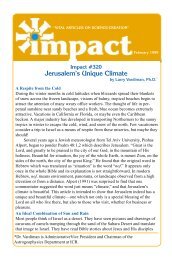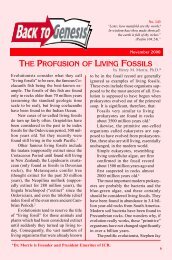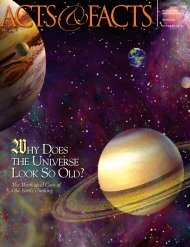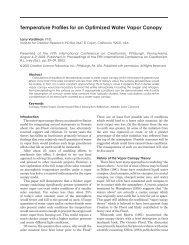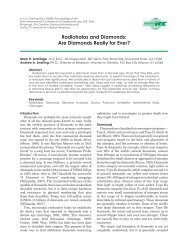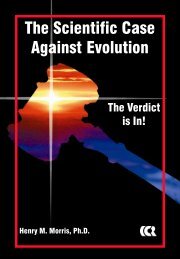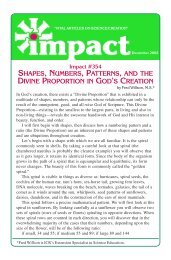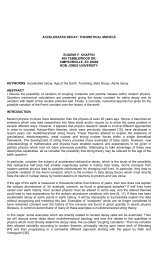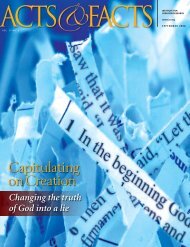Acts & Facts - Institute for Creation Research
Acts & Facts - Institute for Creation Research
Acts & Facts - Institute for Creation Research
You also want an ePaper? Increase the reach of your titles
YUMPU automatically turns print PDFs into web optimized ePapers that Google loves.
IMPACTwarming we’ve experienced <strong>for</strong> the past 150 years is a direct result of anincrease in solar activity and attendant warming.A potential change in cloud cover of 3-4 percent caused by changesin cosmic ray flux is sufficient to explain global temperature changes ofseveral degrees due to the change in the reflectivity of clouds. The reasonthe variation in direct radiation from the sun was rejected earlier is becauseit has been found to vary only by a few tenths of a percent. This isinsufficient to explain observed global warming.Experiments on Cloud Condensation NucleiThese statistical correlations are intriguing, but manycritics are skeptical of Svensmark’s theory until hecan explain the mechanism by which cosmic rayscreate more clouds. This led him to design alaboratory experiment to demonstrate thatcosmic rays produce more cloud nucleion which cloud droplets can <strong>for</strong>m. In2007, Svensmark et al published the resultsof an experiment which confirmedhis theory that cosmic rays increase thenumber of cloud condensation nuclei(CCN). 7Most CCN that nucleate clouddroplets in water clouds near the earth’s surfaceare composed of compounds of sulfuricacid derived from water vapor, sulphur dioxide,and ozone found in the atmosphere over the ocean.Svensmark built a cloud chamber containing these gasesto see if CCN can be multiplied when cosmic rays are introducedinto this mixture. He found that the cosmic rays ionize molecules in theair, releasing electrons that in turn attach themselves to oxygen moleculesand collect other water and sulfur dioxide molecules to <strong>for</strong>m clusters.This process occurs extremely rapidly and many times <strong>for</strong> each electron.The electrons function as a catalyst to <strong>for</strong>m clusters of molecules thatgrow and produce sulfuric acid CCN. When the air is lifted by normalmeteorological processes, these additional CCN <strong>for</strong>m more dense andwidespread clouds because of their greater number.In addition to the results Svensmark obtained from the experimentabove, which he called SKY, he anticipates confirmation of his results in amore complete experiment called CLOUD to be conducted at the CERNlaboratory in Geneva, Switzerland. The experiment at CERN was delayednumerous times, but has now been funded and approved <strong>for</strong> 2010.ConclusionsIt would be prudent<strong>for</strong> the political leadership in theU. S. and the world to look moreclosely at Svensmark’s theoryof cosmoclimatology <strong>for</strong> anexplanation of global warmingbe<strong>for</strong>e restructuring our entireeconomic system to eliminatecarbon dioxide.Svensmark’s theory of cosmoclimatology is now complete. Hehas discovered a complete chain of events that explains the variations inglobal temperature that have puzzled climatologists <strong>for</strong> so many years,and that has now led to an explanation <strong>for</strong> the recent global warmingepisode. It starts with cosmic rays coming to earth from exploding supernovasand collisions of remnants of stars with nebula in space. Manyof these cosmic rays are shielded from striking the earth by the electromagneticactivity of the sun. When the sun is active, the solar windprevents cosmic rays from entering the earth’s atmosphere by sweepingthem around the earth. When the sun is inactive, more ofthem penetrate the atmosphere. Upon reaching thelower atmosphere where more sulphur dioxide,water vapor, and ozone is present, the cosmicrays ionize the air, releasing electrons that aidin the <strong>for</strong>mation of more CCN and <strong>for</strong>mmore dense clouds. This increase in lowcloudamount reflects more solar energyto space, cooling the planet. Variations inelectromagnetic activity of the sun andfluctuations in cosmic ray intensity fromspace result in the periodic warming andcooling of the earth.Solar-modulated cosmic ray processessuccessfully explain the recent globalwarming episode. It would be prudent <strong>for</strong> thepolitical leadership in the U. S. and the world to lookmore closely at Svensmark’s theory of cosmoclimatology<strong>for</strong> an explanation of global warming be<strong>for</strong>e restructuring our entireeconomic system to eliminate carbon dioxide. If, in fact, Svensmark iscorrect, reducing the concentration of carbon dioxide will have littleimpact, anyway.References1. Vardiman, L. 2008. Does Carbon Dioxide Drive Global Warming? <strong>Acts</strong> & <strong>Facts</strong>. 37 (10): 10.2. Svensmark, H. and N. Calder. 2007. The Chilling Stars: A New Theory of Climate Change. Cambridge,England: Icon Books Limited.3. Maunder, E. W. 1904. Note on the Distribution of Sun-Spots in Heliographic Latitude, 1874-1902. Monthly Notices of the Royal Astronomical Society. 64: 747-761.4. Eddy, J. A. 1976. The Maunder Minimum. Science. 192 (4245):1189-1202.5. Robert A. Rohde, www.globalwarmingart.com/wiki/Image:Sunspot_Numbers_png.6. Svensmark, H. 2007. Cosmoclimatology: A New TheoryEmerges. Astronomy & Geophysics. 48 (1): 1.19.7. Svensmark, H. et al. 2007. Experimental evidence <strong>for</strong> the roleof ions in particle nucleation under atmospheric conditions.Proceedings of the Royal Society A. 463 (2078): 385-396.Dr. Vardiman is Chair of the Department of Astro/Geophysics.12 ACTS&FACTS • NOVEMBER 2008



